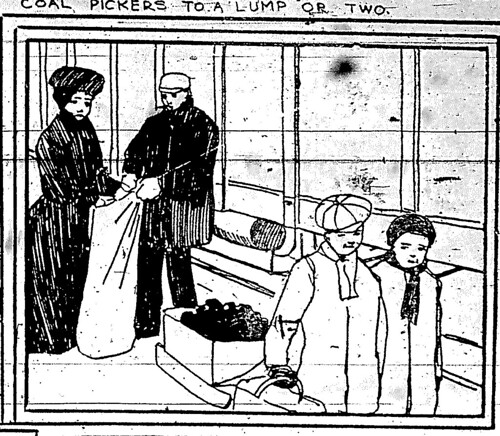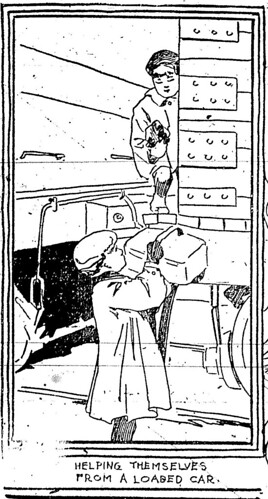In the first few years of the new Twentieth Century, Joplin was a bustling and growing city. New mines brought new wealth, and fortunes were made by men who operated businesses that serviced the mining industry. The wealth did not reach all of Joplin’s residents. Among the misfortunate were the coal pickers:
“The coal pickers of Joplin come from the classes of people who do not submit to the toll of the mines or mill, but depend upon chance employment…and live usually from day to day.”
Coverage of the entrepreneurial poor by a Joplin Globe reporter noted the existence of two types of coal pickers. There were those who operated at night and those during the day, and primarily, a difference between honest and not so honest. In Joplin, it was legal to pick up coal that had fallen from coal cars, but not to take coal directly from the cars. Those who wanted more substantial hauls often climbed into the cars at night with sacks to fill for profit. The reporter noted that the worse the weather, be it blizzard or thunderstorm, the more likely the devious coal pickers were to swarm into the rail yards in search of unguarded coal. Accordingly, the yard watchmen were forced to go out into the night when the elements were at their worse to assure the safety of the coal laden cars.
The “night pickers” as they were described, usually emerged after midnight. One described pair was a father and son. While the father climbed into the car and helped himself to large sacks of coal, his son darted back and forth along the tracks with a wary eye and ear for a patrolling night watchman. As the sun began to rise, other coal pickers arrived.
“Sometimes it is a small boy whose father has passed away, sometimes the girl who wants to help mother earn a livelihood either by providing fuel or by selling it and turning the money into the maternal treasury. Sometimes it is an old man, aged, bent, long past the years of active labor, or, saddest of all, a woman whose life sun is nearing the western horizon.”
The early hours of the day reportedly were the best for finding coal, often accidentally spilled from the cars by the “night pickers.” The other coal came from the bumps in the track as the trains slowly made their way through the city. Another source were the brakemen of the trains, who gazed upon the coal pickers with pity and on occasion walked across the top of the coal cars, and absently knocked off coal with their feet in the progress. When questioned, one brakeman vehemently denied the act, but did so with a twinkle in his eye.
Of the coal pickers described by the reporter, two were an elderly couple. The old man crawled about the cars to reach coal on the ground and handed them to his wife to place in a basket on her arm. Another coal picker was a young boy who led a dog who pulled a small cart. This boy was interviewed by the reporter and spoke of his Dickensian tale:
“You see, father’s dead and mamma’s been sick for a long time, so she couldn’t work. Sister does the dishes for some of the neighbors, and runs errands, and makes about two dollars a week. I make about four dollars picking coal, and that keeps us.”
Some coal pickers found customers on South Main Street amongst the restaurants. One restaurant owner claimed that the difference between buying coal from a coal picker or one of the coal companies was purely sentiment. “My coal costs me as much as anyone in the city…paying it to the coal dealers or to these people who actually need the money. I give mine to these needy people.”
The two most popular spots for the coal pickers were the switch tracks at the Kansas City Bottoms and Smelter Hill, the Tenth Street yards, and the freight yards south of Tenth Street and west of Main Street. Coal cars still rumble through Joplin to points north and south. The less fortunate of Joplin’s residents no longer stalk the rail yards in search of coal as the day of coal in homes and restaurants has long since vanished. The coal pickers of that time were considered part of the “other half,” the poor and the impoverished, whom the daily citizen barely gave a passing glimpse. As the Joplin Globe chose not to ignore them, it’s just as important for our study of Joplin’s history to cover them as all residents of Joplin’s past, whatever their socio-economic status, deserve the chance to be remembered.
Source: Joplin Globe



